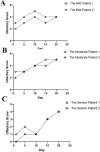Olfactory impairment in COVID-19: Two methods for the assessment of olfactory function
- PMID: 36890807
- PMCID: PMC9979703
- DOI: 10.1016/j.heliyon.2023.e14104
Olfactory impairment in COVID-19: Two methods for the assessment of olfactory function
Abstract
Background: Olfactory impairment is a major symptom of COVID-19. Is it necessary for COVID-19 patients to perform the detection of olfactory function, even how to select the olfactory psychophysical assessment tool.
Methods: Patients infected with SARS-CoV-2 Delta variant were firstly taken into three categories (mild, moderate, and severe) according to the clinical classification. The Odor Stick Identification Test for the Japanese (OSIT-J) and the Simple Olfactory Test were used to assess olfactory function. Moreover, these patients were divided into three groups based on the results of the olfactory degree (euosmia, hyposmia, and dysosmia), too. The statistical analysis of the correlations between olfaction and clinical characteristics of patients were performed.
Results: Our study demonstrated that the elderly men of Han were more susceptible to infected SARS-CoV-2, the clinical symptoms of the COVID-19 patients showed a clear correspondence with the disease type and the degree of olfactory disturbance. Whether or not to vaccinate and whether to complete the whole course of vaccination was closely related to the patient's condition. OSIT-J Test and Simple Test were consistent in our work, indicating that olfactory grading would worsen with the aggravation of symptoms. Furthermore, the OSIT-J method maybe better than Simple Olfactory Test.
Conclusion: The vaccination has an important protective effect on the general population, and vaccination should be vigorously promoted. Moreover, it is necessary for COVID-19 patients to perform the detection of olfactory function, and the easier, faster and less expensive method for determination of olfactory function should be utilized to COVID-19 patients as the vital physical examination.
Keywords: COVID-19; Coronavirus; Olfactory impairment; Physical examination; SARS-CoV-2.
© 2023 The Authors. Published by Elsevier Ltd.
Conflict of interest statement
The authors declare no competing interests.
Figures
























Similar articles
-
Suitability of the odor stick identification test for the Japanese in patients suffering from olfactory disturbance.Acta Otolaryngol Suppl. 2004 Aug;(553):74-9. doi: 10.1080/03655230410017715. Acta Otolaryngol Suppl. 2004. PMID: 15277041
-
[Olfactory disturbance screening with the odor stick identification test (OSIT-J) in executive checkups].Nihon Jibiinkoka Gakkai Kaiho. 2007 Aug;110(8):586-91. doi: 10.3950/jibiinkoka.110.586. Nihon Jibiinkoka Gakkai Kaiho. 2007. PMID: 17874540 Japanese.
-
[Odor stick identification test for Japanese patients with olfactory disturbances].Nihon Jibiinkoka Gakkai Kaiho. 2006 Sep;109(9):689-95. doi: 10.3950/jibiinkoka.109.689. Nihon Jibiinkoka Gakkai Kaiho. 2006. PMID: 17025219 Japanese.
-
The Importance of Considering Olfactory Dysfunction During the COVID-19 Pandemic and in Clinical Practice.J Allergy Clin Immunol Pract. 2021 Jan;9(1):7-12. doi: 10.1016/j.jaip.2020.10.036. Epub 2020 Oct 28. J Allergy Clin Immunol Pract. 2021. PMID: 33130145 Free PMC article. Review.
-
Olfactory dysfunction and dementia in Parkinson's disease.J Parkinsons Dis. 2014;4(2):181-7. doi: 10.3233/JPD-130277. J Parkinsons Dis. 2014. PMID: 24625830 Review.
References
LinkOut - more resources
Full Text Sources
Miscellaneous

